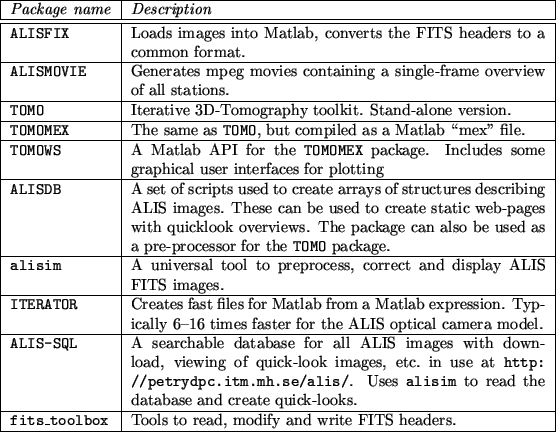 |
 |
 |
To classify auroral images is not a straight-forward task. As noted by Brändström et al. [1998] it is sometimes difficult, even for an experienced observer, to discriminate between for example diffuse aurora and aurora behind thin clouds (Figure 6.1).
![\includegraphics[width=\textwidth]{eps/science/ai/black2.eps}](img498.png)
|
Early on in the ALIS project, an auroral classification scheme was
suggested (by Åke Steen, see Table 6.3).
| ||||||||||||||||||||||||||||||||||||||||||||||||||||||||||||||||||||||||||||||||||||||||||||||||||||||||||||||||
In an exploratory study carried out by Eide et al. [1997]; Waldemark et al. [1997] Pulse Coupled Neural Networks (PCNN) were evaluated as a preprocessor for classifying image-data from ALIS. The PCNN is a biologically inspired neural network based on findings in the visual cortex of small mammals. The algorithm has been successfully applied in the field of mammography [Kinser and Lindblad, 1997] which, to some extent, possesses similar image processing and classification problems as encountered in auroral imaging. A three-step procedure for automatically classifying auroral images is outlined: (1) use a PCNN for image segmentation, (2) post-process the resulting data, either by using Singular Value Decomposition (SVD) or by applying a second PCNN for feature extraction, (3) carry out the actual classification using a traditional neural network. This work was followed up by Rydesäter et al. [1998] who concentrated on the problem of how to find auroral arcs, and on their location within the images. For this purpose an arc detection algorithm was constructed and tested. Initial attempts were made to enhance the algorithm with a Radial Basis Neural Network (RBNN). It was concluded that the arc detection algorithm gave a robust detection of auroral arcs and their direction. Preliminary results from the application of a RBNN was promising.
Alpatov et al. [2000] applied self-organising neural networks to ALIS data, for the detection of polar stratospheric clouds.
A different approach to the problem of automatic recognition of auroral forms is studied by Pudovkin et al. [1998]. Here a more traditional method, based on the analysis of isolines of auroral luminosity shapes is utilised. Classical forms such as ellipses, spirals and folds appear to be confidently retrieved. However, Pudovkin et al. [1998] notes that the entire field of auroral classification seems to be at an early stage: ``There are needs for extensive and purposeful studies of the forms peculiar to certain geophysical conditions, with the nature of the physical process within the auroral plasma and their characteristic time and space scales being taken into account.''
Rydesäter [2001] presents a survey of possible methods of implementing a Selective Imaging Technique (SIT) functionality in ALIS, as proposed by Steen et al. [1997a]. (This would be an algorithm or a device that automatically controls ALIS, or advises the operator to acquire data of specific interest when favourable conditions occur.)
A study on the effects of lossy compression of auroral image data is presented in Rydesäter et al. [2003]. At least for the images studied, it appears to be possible to compress images to approximately 5-12% of their original size without increasing errors.
Another topic is the study of the fractal dimension of auroral features. An initial study was carried out by Alpatov et al. [1996b]; Alpatov et al. [1996a]. It was concluded that fractal analysis methods can be used to segment auroral images into aurora, stars, clouds and background. However it remains to be seen if segmentation of the auroral features themselves can be related to physical processes responsible for the aurora.
Despite the fact that these studies provided promising preliminary results, much work remain before these methods can be applied to auroral imaging on a regular basis.
Apart from the work related to ALIS, many other groups are working in this field. An example of this is the very promising work by Syrjäsuo [2001, and references therein] on auroral detection/classification by automated image analysis.